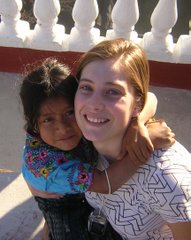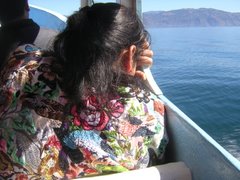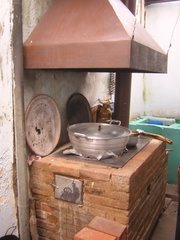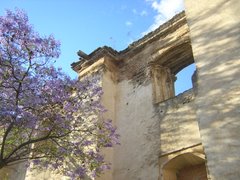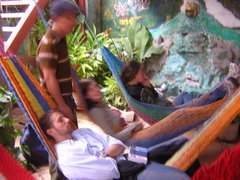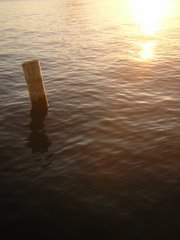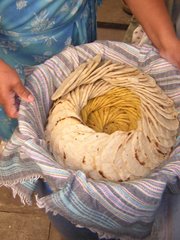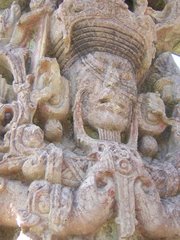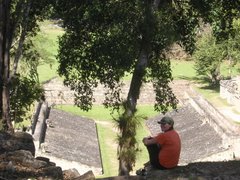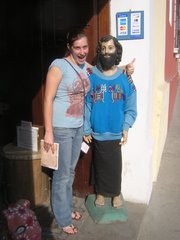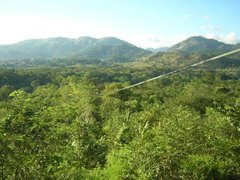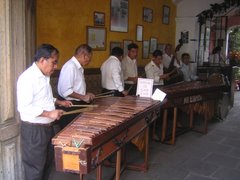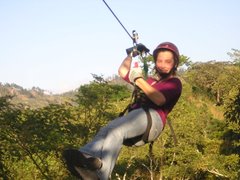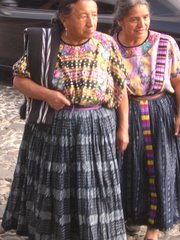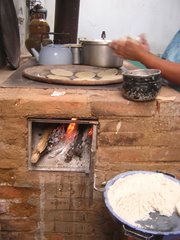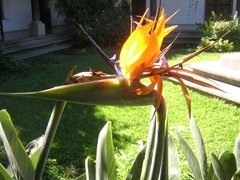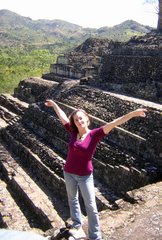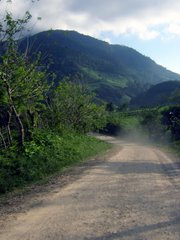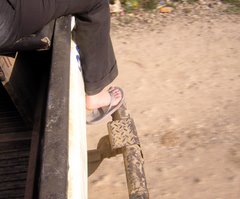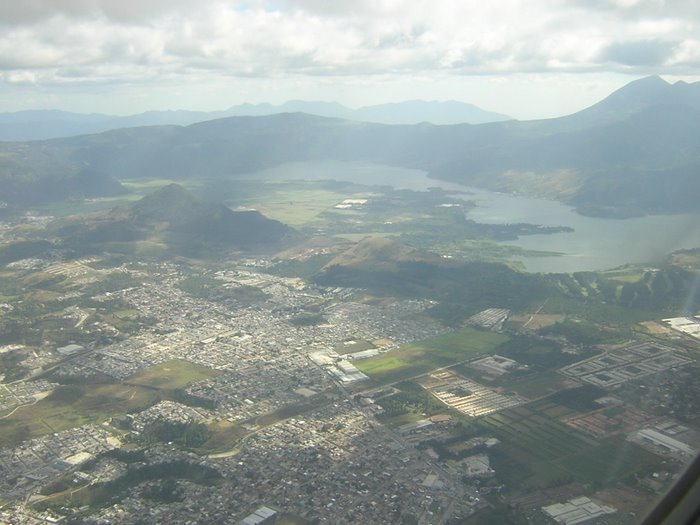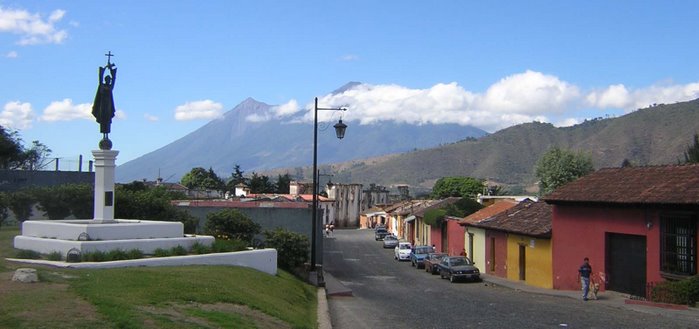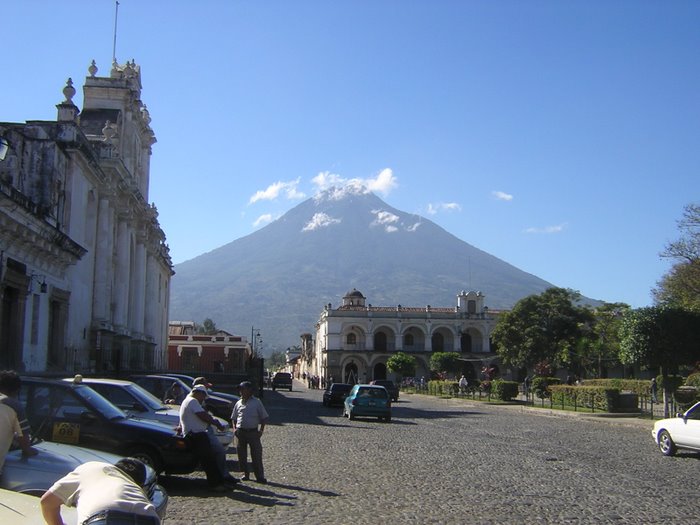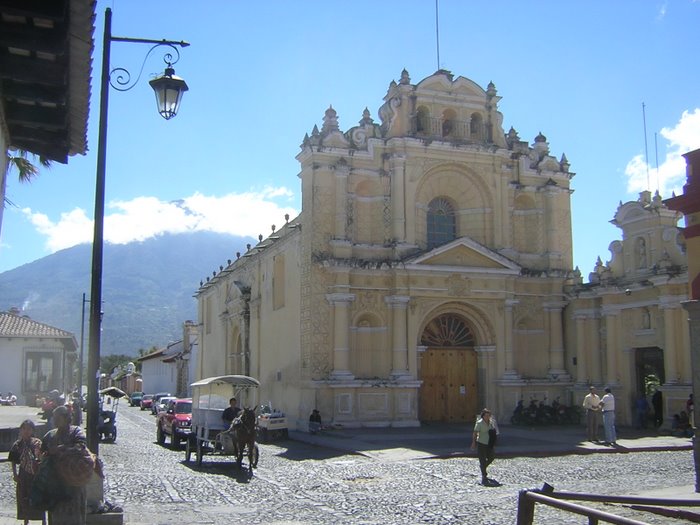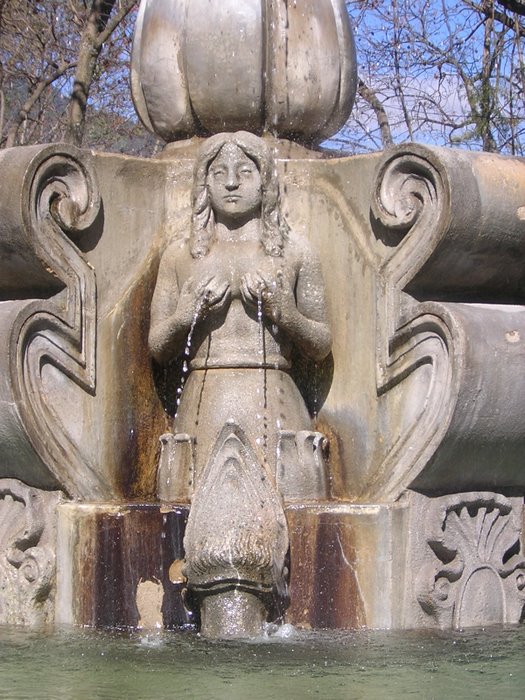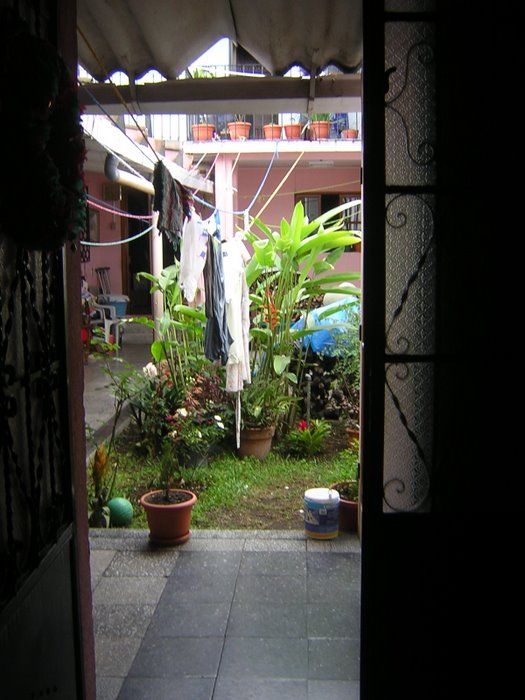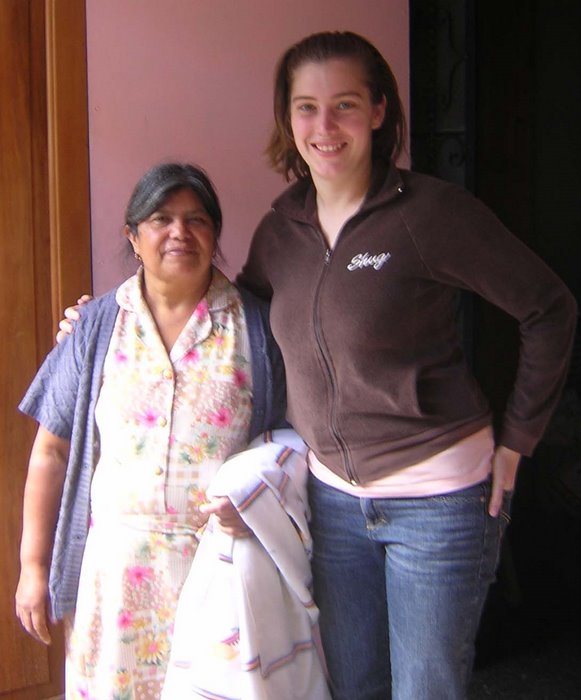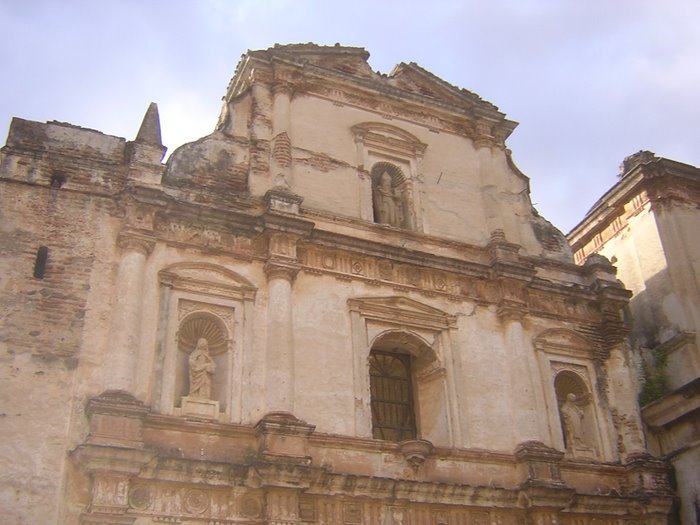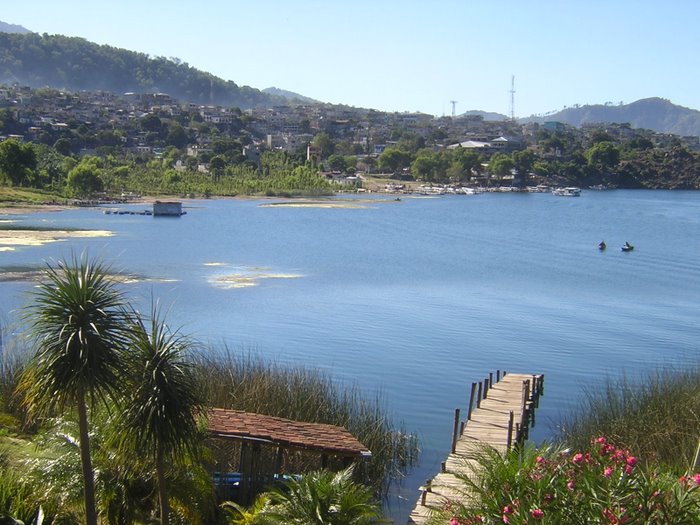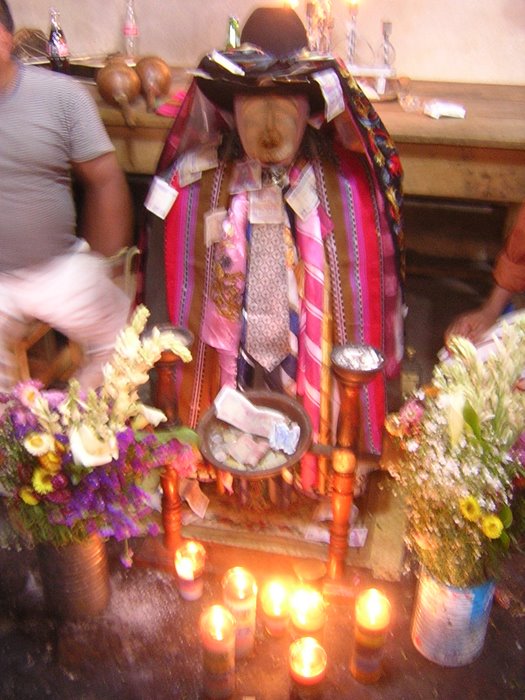
Walking late at night in the lamp lit sidewalks with the crisp night air swirling down the empty cobblestone streets. Trying to cross the street while tuk-tuk’s fly by with their lawn-mower engines pattering loudly and single headlight lighting the way. Hesitantly stepping out into the mix of traffic (horse-drawn carriages, man-pulled carts, chicken buses, motorcycles, and
Toyota trucks). Successfully crossing the street to the parque central where couples gaze lustily into each other’s eyes (I am surprised at how openly young people lock lips), voices and guitars sing private concerts, and the fountain glows different colors as it bubbles. This is Antigua at night. But tonight is different. Tonight a huge crowd is gathered near the entrance of the central cathedral, which is also lit up. Spotlights cast eerie shadows of stone saints on the white cathedral walls. A crowd of several hundred people spills from the park and into the street, gathering around a large stage where a full orchestra and choir (in full tuxedos and gowns) plays salsa, classical, and jazz music. The conductor speaks in between sets in Spanish and explains that this concert is for art, it is not for commercialism, not for sale, not even to promote this band, it is just for art's sake; and everyone is welcome to enjoy the beauty of the music. (Jill are you drooling yet?) So underneath the stars, with the clouds playing between the distant volcano-tops, I stood with 500 strangers. 500 other appreciators of music from all walks of life - from well cultured tourists from all over the world, to Maya locals who had never before heard anything like it. We stood and we listened to a free music. That was Saturday night in
Antigua, Guatemala - also known as my home for the next four months. Seriously, does it get any better than this?
I have written all about my weekend excursions, but have yet to write anything about Antigua, so here are some slices of life from my hometown:
I bought a membership to a local gym, to keep all the frijoles and arroz (beans and rice) from doing too much damage, where I decided to try out an Aerobics class. And what a class! I have taken dance and work-out classes back in the States lots of times, but they were nothing like this one. “Aerobics” was really a non-couple version of salsa, with the students and instructor laughing and dancing the entire time. The music was banging, and you could barely hear the teacher speak (in English or Spanish), so to get our attention he would whistle, pat his head and use his arms to tell us what to do next. It was a blast. Definitely the most relaxed gym experience of my life; no one was trying to impress each other with their mighty moves or muscles, it was just fun.
Speaking of salsa… we checked out a dance club where all the locals go to dance and I was blown away. There was one couple that stopped me mid booty-shake (and you know how I like to booty shake), because I just had to watch them; they commanded and owned to dance floor. Salsa like I’ve never seen! The girl broke her heel mid dance, but did that stop her from doing the splits on the ground while her partner danced above her? Hell no! They were incredible, and after the salsa music switched to hip hop the guy challenged me to a dance off; much to his surprise I matched most of his moves. We both laughed and his partner came over to show me a few of the female salsa moves. It was a blast.
Here are some other experiences of Antigua:
-Being the only one who jumps every time celebratory fireworks go off in the street. (And this happens frequently. We are talking LOUD enough to be bombs, what a way to say happy birthday!)
-Teaching my host dad, Luiz, su-do-ku in Spanish; a true test of my Spanish skills.
- Watching the indigenous cows drive by in the street in front of my house on their final drive to the slaughter house.
- Sitting in the park and talking to teenage boys as they pull a prank with super glue on one of their friends.

- “Making” tortillas with Victoria (she laughed at my state shaped tortillas).
- Peering in one of the grand cathedrals and seeing at the very front of the church, on their knees in prayer, was a bride and groom taking their vows with their clans seated behind them.
- Watching incredibly elaborate religious processions, where 100 people hold up a memorial sculpture of Jesus on their backs and walk around the city, stopping at holy spots. (See pictures above)
- Reverently watching smoke plumes waft from the still active volcano Fuego (which means fire).
- Stepping foot into an old colonial hacienda which is now the largest and nicest McDonald’s I have ever seen. Can you believe it? I bet the original family never would have guessed that their elaborate home would one day become a fast-food chain.
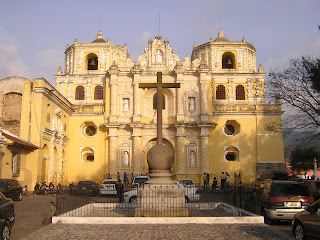 Yesterday, Chrissie, Pablo and I visited an incredible cathedral (see picture). While we were poking our noses around, the services started, so we took a seat. The services were in some unidentifiable language, not Spanish, not Latin, not Maya, and most of the attendees were “ladinos,” (non-indigenous) or tourists. Whatever language it was, it didn’t lose its power, but in fact became more moving in my eyes, because I realized that the people around me knew the service and message of the priests in spite of their varying native tongues. When we greeted the congregation around us, shook hands and hugged, it was incredibly powerful to know that these people who were from different countries, races, and worlds, were equal in this moment under the eyes of their god. They were equal servants and the customs or differences that usually forbade them to interact openly with each other disappeared. The faith of the attendees themselves was inspiring; an old couple sat in front of us on the wooden benches, and the woman struggled to pray on her knees while her husband, equally as frail, helped steady her. The thought of how old the church was, and how many prayers had been uttered here over the decades struck me. There is just nothing like that in Arizona. There are no churches that stir awe in your heart from the sheer beauty of the architecture and religious art (Ok, San Javier comes close). I understand now Danny, why you always reply “I was raised catholic” when someone asks your religious views; it’s not to describe your current beliefs, but to express the pride and culture that you grew up with. I will definitely be attending mass again, and hopefully next time in Spanish.
Yesterday, Chrissie, Pablo and I visited an incredible cathedral (see picture). While we were poking our noses around, the services started, so we took a seat. The services were in some unidentifiable language, not Spanish, not Latin, not Maya, and most of the attendees were “ladinos,” (non-indigenous) or tourists. Whatever language it was, it didn’t lose its power, but in fact became more moving in my eyes, because I realized that the people around me knew the service and message of the priests in spite of their varying native tongues. When we greeted the congregation around us, shook hands and hugged, it was incredibly powerful to know that these people who were from different countries, races, and worlds, were equal in this moment under the eyes of their god. They were equal servants and the customs or differences that usually forbade them to interact openly with each other disappeared. The faith of the attendees themselves was inspiring; an old couple sat in front of us on the wooden benches, and the woman struggled to pray on her knees while her husband, equally as frail, helped steady her. The thought of how old the church was, and how many prayers had been uttered here over the decades struck me. There is just nothing like that in Arizona. There are no churches that stir awe in your heart from the sheer beauty of the architecture and religious art (Ok, San Javier comes close). I understand now Danny, why you always reply “I was raised catholic” when someone asks your religious views; it’s not to describe your current beliefs, but to express the pride and culture that you grew up with. I will definitely be attending mass again, and hopefully next time in Spanish.
 One clear difference in the conception of Catholicism in Guatemala is the focus on suffering. Most of the religious services I have attended in the U.S. focused on the renewing powers of Jesus, or of his rebirth, but here all the imagery and idolatry is focused on the pain and suffering of Jesus (or Mary) in his final hours. The processionals that I have seen pass by were of worshipers actually, physically carrying the burden of a thousand pound sculpture of their savior dying on their backs. If that isn't a clear testimony of what is important to these people, I am not sure what is. I think this aspect of Christianity really resonates with Guatemalans because of their harrowing pasts. It was only 10 years ago that the 30 year long civil war ended, and this is obvious from the persistent undertones of violence and suspicion in Guatemalan culture. Guatemalans don’t trust their government, their banks (for obvious reasons), or their military. Instead, they carry concealed weapons and trust in the suffering that God endured for them, and hope that their own suffering in this life will lead to better one after death.
One clear difference in the conception of Catholicism in Guatemala is the focus on suffering. Most of the religious services I have attended in the U.S. focused on the renewing powers of Jesus, or of his rebirth, but here all the imagery and idolatry is focused on the pain and suffering of Jesus (or Mary) in his final hours. The processionals that I have seen pass by were of worshipers actually, physically carrying the burden of a thousand pound sculpture of their savior dying on their backs. If that isn't a clear testimony of what is important to these people, I am not sure what is. I think this aspect of Christianity really resonates with Guatemalans because of their harrowing pasts. It was only 10 years ago that the 30 year long civil war ended, and this is obvious from the persistent undertones of violence and suspicion in Guatemalan culture. Guatemalans don’t trust their government, their banks (for obvious reasons), or their military. Instead, they carry concealed weapons and trust in the suffering that God endured for them, and hope that their own suffering in this life will lead to better one after death.
 Walking late at night in the lamp lit sidewalks with the crisp night air swirling down the empty cobblestone streets. Trying to cross the street while tuk-tuk’s fly by with their lawn-mower engines pattering loudly and single headlight lighting the way. Hesitantly stepping out into the mix of traffic (horse-drawn carriages, man-pulled carts, chicken buses, motorcycles, and
Walking late at night in the lamp lit sidewalks with the crisp night air swirling down the empty cobblestone streets. Trying to cross the street while tuk-tuk’s fly by with their lawn-mower engines pattering loudly and single headlight lighting the way. Hesitantly stepping out into the mix of traffic (horse-drawn carriages, man-pulled carts, chicken buses, motorcycles, and 










